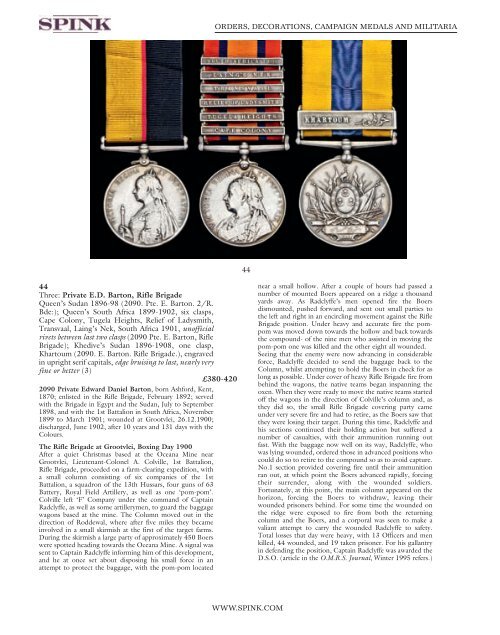orders, decorations, campaign medals and militaria - Spink
orders, decorations, campaign medals and militaria - Spink
orders, decorations, campaign medals and militaria - Spink
Create successful ePaper yourself
Turn your PDF publications into a flip-book with our unique Google optimized e-Paper software.
44<br />
Three: Private E.D. Barton, Rifle Brigade<br />
Queen’s Sudan 1896-98 (2090. Pte. E. Barton. 2/R.<br />
Bde:); Queen’s South Africa 1899-1902, six clasps,<br />
Cape Colony, Tugela Heights, Relief of Ladysmith,<br />
Transvaal, Laing’s Nek, South Africa 1901, unofficial<br />
rivets between last two clasps (2090 Pte. E. Barton, Rifle<br />
Brigade); Khedive’s Sudan 1896-1908, one clasp,<br />
Khartoum (2090. E. Barton. Rifle Brigade.), engraved<br />
in upright serif capitals, edge bruising to last, nearly very<br />
fine or better (3)<br />
£380-420<br />
2090 Private Edward Daniel Barton, born Ashford, Kent,<br />
1870; enlisted in the Rifle Brigade, February 1892; served<br />
with the Brigade in Egypt <strong>and</strong> the Sudan, July to September<br />
1898, <strong>and</strong> with the 1st Battalion in South Africa, November<br />
1899 to March 1901; wounded at Grootvlei, 26.12.1900;<br />
discharged, June 1902, after 10 years <strong>and</strong> 131 days with the<br />
Colours.<br />
The Rifle Brigade at Grootvlei, Boxing Day 1900<br />
After a quiet Christmas based at the Oceana Mine near<br />
Grootvlei, Lieutenant-Colonel A. Colville, 1st Battalion,<br />
Rifle Brigade, proceeded on a farm-clearing expedition, with<br />
a small column consisting of six companies of the 1st<br />
Battalion, a squadron of the 13th Hussars, four guns of 63<br />
Battery, Royal Field Artillery, as well as one ‘pom-pom’.<br />
Colville left ‘F’ Company under the comm<strong>and</strong> of Captain<br />
Radclyffe, as well as some artillerymen, to guard the baggage<br />
wagons based at the mine. The Column moved out in the<br />
direction of Roddewal, where after five miles they became<br />
involved in a small skirmish at the first of the target farms.<br />
During the skirmish a large party of approximately 450 Boers<br />
were spotted heading towards the Oceana Mine. A signal was<br />
sent to Captain Radclyffe informing him of this development,<br />
<strong>and</strong> he at once set about disposing his small force in an<br />
attempt to protect the baggage, with the pom-pom located<br />
<strong>orders</strong>, deCoratioNs, CampaigN medaLs aNd miLitaria<br />
44<br />
WWW.spiNK.Com<br />
near a small hollow. After a couple of hours had passed a<br />
number of mounted Boers appeared on a ridge a thous<strong>and</strong><br />
yards away. As Radclyffe’s men opened fire the Boers<br />
dismounted, pushed forward, <strong>and</strong> sent out small parties to<br />
the left <strong>and</strong> right in an encircling movement against the Rifle<br />
Brigade position. Under heavy <strong>and</strong> accurate fire the pompom<br />
was moved down towards the hollow <strong>and</strong> back towards<br />
the compound- of the nine men who assisted in moving the<br />
pom-pom one was killed <strong>and</strong> the other eight all wounded.<br />
Seeing that the enemy were now advancing in considerable<br />
force, Radclyffe decided to send the baggage back to the<br />
Column, whilst attempting to hold the Boers in check for as<br />
long as possible. Under cover of heavy Rifle Brigade fire from<br />
behind the wagons, the native teams began inspanning the<br />
oxen. When they were ready to move the native teams started<br />
off the wagons in the direction of Colville’s column <strong>and</strong>, as<br />
they did so, the small Rifle Brigade covering party came<br />
under very severe fire <strong>and</strong> had to retire, as the Boers saw that<br />
they were losing their target. During this time, Radclyffe <strong>and</strong><br />
his sections continued their holding action but suffered a<br />
number of casualties, with their ammunition running out<br />
fast. With the baggage now well on its way, Radclyffe, who<br />
was lying wounded, ordered those in advanced positions who<br />
could do so to retire to the compound so as to avoid capture.<br />
No.1 section provided covering fire until their ammunition<br />
ran out, at which point the Boers advanced rapidly, forcing<br />
their surrender, along with the wounded soldiers.<br />
Fortunately, at this point, the main column appeared on the<br />
horizon, forcing the Boers to withdraw, leaving their<br />
wounded prisoners behind. For some time the wounded on<br />
the ridge were exposed to fire from both the returning<br />
column <strong>and</strong> the Boers, <strong>and</strong> a corporal was seen to make a<br />
valiant attempt to carry the wounded Radclyffe to safety.<br />
Total losses that day were heavy, with 13 Officers <strong>and</strong> men<br />
killed, 44 wounded, <strong>and</strong> 19 taken prisoner. For his gallantry<br />
in defending the position, Captain Radclyffe was awarded the<br />
D.S.O. (article in the O.M.R.S. Journal, Winter 1995 refers.)

















